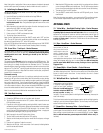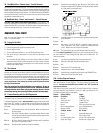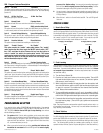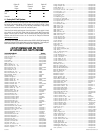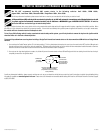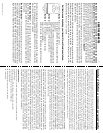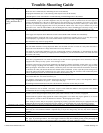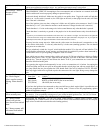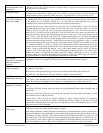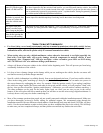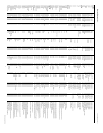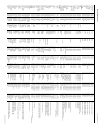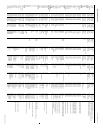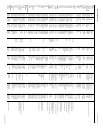
© 2005 Directed Electronics, Inc. 1 Trouble Shooting v4-1
Trouble-Shooting Guide
Unit won’t respond
Make sure unit has power and ground.
Make sure unit is initialized (See ‘Initializing the unit’ in the manual)
Re-program transmitter. (See ‘Code Learning’ under Special Cases in the manual).
Check Diagnostic Code as described in Trouble Shooting with Self Diagnostics in the manual.
What is the Diagnostic
Code, and how do I
get it?
The Self-Diagnostics built into every DesignTech brand remote start will help identify problems in both the unit and
your installation. To get an accurate diagnostic code, flip the toggle switch off and back on; the LED light (on
module) should flash once if the unit is initialized. Press the start button on your transmitter for second. Now allow
the unit to try and start your vehicle 1-3 times. (Note that the unit will attempt to start the vehicle up to 3 times unless
codes 2,5,7 or 8 are being triggered, when it will try and start the vehicle once). Allow it up to a minute to try to start
again on its own - Don’t do ANYTHING to the unit during this time, unless something goes obviously wrong. At the
end of the starting cycles, turn the toggle off and count the first series of flashes- this will be the diagnostic code.
Diagnostic Code 1 flash The unit may not have attempted to start the vehicle yet or the unit may have started and timed out.
Is the toggle switch upside down? When the switch is turned on the LED will flash once immediately.
Something might be causing the unit to reset, such as a poor connection to ground or power, or you may have a relay
wired improperly. Typically the wires in the control harness require a relay unless otherwise stated.
The transmitter may need to be programmed.
Diagnostic Code 2 flashes The unit thinks the hood is open. Make sure the hood pin-switch is properly adjusted and installed.
The unit thinks the brake is being depressed. Make sure the brake wire has 12 volts on it only when the brake is
depressed. There should be no voltage on the brake wire at any other time
You might be experiencing feedback if you have connected the parking or head-lights. If disconnecting the lights
wire allows the unit to start then you might power the headlights, or you can isolate the brake wire of the unit from
the vehicle with a relay.
Diagnostic Code 3 flashes If the unit is programmed for tach, the tach wire is not connected or the tach rate may not yet have been learned.
If the unit is programmed for ‘No-Tach’ the vehicle may not have all the required ignition wires connected, or may be
equipped with a factory security system – thus causing it to stall.
Sometimes a unit may have an option programmed even though you did not specifically set that option. Try re-setting
the unit. Unplug everything from the module except the black ground wire and LED (if you have a plug-in LED).
While pressing the white button on the module, connect the power lead. The LED on the unit should turn on and stay
on. Release the white push button and the LED should remain illuminated. (If not, repeat the process being sure to
hold in the white button while connecting power.) Now remove power and wait 2 minutes. Then connect the power
without pushing any buttons. Re-Initialize the unit and it should work for you.
Diagnostic Code 4 flashes Make sure the remote input wire (usually red/white) is not touching anything. (This wire is not on all models). If you
have a stick shift unit – this is not relevant to you.
You might be pressing the remote control again before the unit has completed its cycle(s)---See 'Diagnostics: What is
the Diagnostic code and how do I get it?’ – at the top of this page.
If installing a manual transmission unit, this code means the unit did not see the door pin-switch.
Diagnostic Code 5 flashes This code means the unit thought the transmission was shifted into gear.
If the transmission was not shifted: Switch the “in-gear” switch inside the module to the off position. This disables
‘Transmission in Gear’ sensing, and should solve the problem.
Diagnostic Code 6 flashes Code 6 is caused by the unit not seeing the battery voltage increase enough when the vehicle starts. It can also be
caused if you are not bypassing the factory theft system, such as PATS, VATS, or similar, if equipped.
Double-check the ignition wiring against the vehicle-wiring guide. Your vehicle may require ignition 2, or in some
cases ignition 3, in order to allow the alternator to function – thus bringing up the voltage.
If the wiring is correct, and you are properly bypassing any security system the vehicle may be equipped with, then
connecting the unit into tach mode should solve the problem. (Your alternator may not be functioning properly).
Diagnostic Code 7 flashes An alarm sensor was triggered, causing the vehicle to shut down. (Only applies to units that have alarm features).
Diagnostic Code 8 flashes Something in the control harness is not connected properly. One of the transistor outputs is driving too much current.
There may be a wire connected without a required relay, or if you are using a relay, the relay may not be connected
properly.
Diagnostic Code 9 flashes Applicable only to manual transmission units. Indicates the unit did not see the emergency brake.
Diagnostic Code 10/11 flashes These are not a valid codes.
Diagnostic Code 12 flashes Make sure you have an accurate code. Please see ‘What is the Diagnostic Code, and how do I get it?’ at the top of
this page. If you still get code 12, one of the toggle switch wires may have touched ground, possibly damaging the
unit. Or maybe the switch was just turned off while it was running. Or maybe a defective switch?



